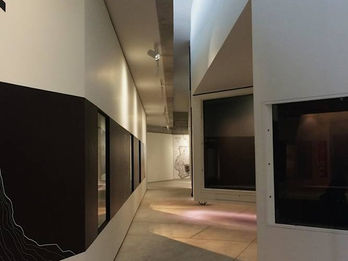2016 Americas Prize

Pachacamac Museum
Patricia Llosa, Rodolfo Cortegana
Lurin, Lima, Peru
November 2015
AUTOR PRINCIPAL
Llosa Cortegana arquitectos
AUTOR CONTRIBUYENTE
Daniela Chong (Collaborator) Angelica Piazza (collaborator) Llona Zamora (collaborator)
CLIENTE
Ministerio de Cultura del Perú
FOTÓGRAFO
Juan Solano Evelyn Merino Reyna Buchanan
OBJETIVO
The project was born from its relationship with the territory, its topographic trace and the ability to establish itself as a mediator with the Sanctuary. The exterior pathway spaces nest in their need to frame the prehistoric temples. The building itself adapts to its surroundings directing their views reinforcing the relationship with sacred buildings. Its volumes are folded in an earthquake gesture, (Pachacamac was known as the Earthquakes God) and stressed between their external pathway ramp gaps, associated with the pre hispanic streets where the pilgrims approached their temples in linear spaces within its large scale walls. Its mass, expressed in their rough concrete walls are associated with the pre hispanic earth wall structures, the limb in an attempt to build a kind of shadow typology, the project avoids composition perforations. The project defines its form on the wall. The building places itself in a “weak” attitude towards its environment; the scale is handled in complicity with the topography and the unevenness of the ground to avoid breaking abruptly into the place. It is only when you descend to the meeting Plaza, where the building is revealed in its full scale. The building expresses its deep respect for the sacred territory and manifests as another laminating layer in the long process of transformation of the Sanctuary
CONTEXTO
The Sanctuary of Pachacamac is a place where the pre-Hispanic architecture moves us by its silence and scale; its long paths confined by impressive wall structures permanently confront us with the worship places. Its relationship with the environment is defined by traces organizing the occupation over time. Pre hispanic architects understood that architecture was a mediation between man and the worship of gods, with a deep tradition were permitted to operate its projects within territory adaptation strategies. Thus, the building tradition was defining its architecture and adding on innovations upon its territory and circumstances. Therefore, the museum emerges from a lightness that contrasts to the massive pre hispanic elements, its wall structures define its trace and its pathways between the large scale walls are in constant tension with the Sanctuary. The Museum tries to turn its sacred territory into a museum piece itself. Contemporary architecture talks of pre-Hispanic architecture, taking its elements and building an alternative grammar with which it allows itself to inhabit the symbolic landscape and define spaces to frame the Sanctuary. The museum project was born from his relationship with the Territory and its topographic trace.
ACTUACIÓN
The museum tries to have the least visual impact on the sacred territory, but at the same time generate the greatest impact on their relationship with the community. In Peru due to the lack of public spaces and social meeting places, buildings like this become one of the few places of appropriation for the population. Pachacamac Museum is a tool for the state to re-establish links with our ancient past, and to generate a sense of respect for heritage. Pachacamac is a place in constant digging and research and the museum program in addition to the exhibition spaces with the right archaeological conditions includes spaces for research and conservation as well as spacious storages to protect the cultural heritage. The archaeological Sanctuary of Pachacamac is surrounded by the spontaneous growth of the city, generating in recent years constant friction with the nearby population. That is why the museum tries to amplify the experience of visiting the monuments, as well as becoming a place of approach, encounter and a link between the population and its pre-Columbian past often forgotten.











